Why is video important for schools to create and invest in?
Your school is competing for attention against everything else that your audience encounters. Not using video allows your school to slide to back of mind while other content comes to the front. After all, video represents the majority of content people consume online, rising to 65% of global internet traffic in 2022 according to Sandvine (source: 2023 Global Internet Phenomena Report). Furthermore, Wyzowl’s latest video marketing survey found that “91% of people say they want to see more online videos from brands in 2023” (source: Video Marketing Statistics 2023).
For the article below, Foxbright's marketing team partnered with the school video experts at Ghering Media to give you everything you need to get started.
What are some of the best ways schools can use video to connect with their audiences or community?
Schools can use video for a lot of purposes, through a variety of tactics. For example, keep your school community informed and engaged with a video update from the principal embedded in the weekly email newsletter. Drive enrollment inquiries by creating a testimonial from a current family and featuring it on social media. Supercharge fundraisers by detailing needs in a video and showing it at an event. More than any other format, video allows you to infuse your communications with an emotional impact that affects your audience. As one of our clients put it:
“the beautiful video [Ghering Media] created for SJV’s auction touched everyone’s heart and shared our story in the best way - in the voice of our students, parents, and teachers.”
Video captures your audience’s attention in a way that isn’t matched by other formats.
3 options to create school promotional videos
“We can see it’s important, so now we want to start using more video in our school communications.”
 #1 The DIY approach
#1 The DIY approach
There are several software and equipment options that allow schools to take a 'do-it-yourself' approach to video creation (we’ll dive deeper into tactics on how to do that below.) These can range from free models to professional paid software. Many platforms could be built into your devices already, but if you're looking for an elevated option we've evaluated and priced out:
- Animoto: Free basic option, up to $468/year for professional capabilities
- WeVideo: $89/year for single teacher option
- Movavi: $54.95/year for basic video editing option
- Adobe Premiere: $19.99/month (for the first year) for the student/teacher option
The do-it-yourself approach has a lot of advantages. The financial investment is low to non-existent. It’s also more nimble; you can quickly film something spur-of-the-moment since you’re already on campus, whereas that’s not easy with a vendor. However, there are learning curves to even the simplest softwares so avoid taking it on if there’s not room on your plate.
#2 Community Champion
Another creative approach is to involve a volunteer from the school community. There may be a parent, for instance, who is familiar with videography, passionate about your school and generous with their time and equipment. Again, the financial investment is low or even zero. But a disadvantage may be that the video is a higher priority for you than it is for them, leaving you to wonder when it will get done.
You might also check with your district. If communication assistance is among the shared services provided by the administration, there could be someone on staff who can make a video.
#3 Hiring the Right Vendor
Finally, there’s the route of hiring a videographer or production company. While this option involves the biggest financial investment, a skilled professional will be able to show you past work and describe how they’ve delivered a return for their clients. Hiring out your video gives you back the time you would have spent on learning some basic production techniques, filming content, and editing.
When you inquire about video production services, make sure they understand your goal and ask them their approach to helping you succeed. A quality video is very effective for meeting your school’s needs, and that same Wyzowl survey we mentioned above also found that 92% of marketers who use video say it gives them a good return on their investment.
Helpful tips for DIY school videos
Understand your audience
You could have the best equipment on the market and Steven Spielberg behind the camera, but if you don't spend the necessary pre-production work planning your video, it'll be doomed to fail.
The first step of every successful school video is to ensure you fully understand your audience. Three helpful questions to get started include:
- What demographic are you trying to reach? A recruitment video for parents will have a much different feel than an internal video for teachers.
- What are the specific needs, concerns, and/or questions your audience has and how can this video clearly answer them?
- Where will you be primarily sharing the video? For example, if you're creating for Facebook or Instagram, you'll want to consider framing the the video vertically vs. horizontally.
Consider this example from Our Lady of Consolation School. This client's goal was to connect with local parents on Instagram to showcase how the parish's education offerings are personalized to meet individual students' learning needs:
Keep the main thing the main thing
Identify the key takeaway before recording. Write a script which clearly communicates that takeaway, and list any b-roll (supporting visuals) you’ll need to support the message. Keep the takeaway straightforward so that the audience can easily follow it.
A common pitfall is to try to solve all communication needs in just one single video. This often muddles the message and always increases the length (in 2023, viewers have the attention spans of hummingbirds!) Make the video only as long as needed to convey the takeaway, and cut out everything you can.
Here’s an example from a Ghering Media client who wanted to highlight their teachers’ dedication to student success:
OR, consider this brand video for Saint Thomas the Apostle Catholic School. Sharing one's mission, beliefs, and services would be very difficult (if not impossible!) to do in under a minute.
But by maintaining an energetic pace and backed by a strong, clear narrative, this has become one of the best ways the school can clearly and succinctly introduce themselves to their audience.
Don’t make them work to hear it
Audio quality is very important for keeping your audience. If they can’t understand what’s being said, they’ll stop watching. A good DIY method is using a lavalier mic connected to your filming device (whether that’s a phone or a dedicated camera). Clip the mic to your subject’s shirt placket, sweater collar, or jacket lapel; being close like this helps the audio quality. Hide the wire if you can. Test the mic and make sure you can easily understand the person who’s speaking.
If you need to buy a microphone, there are some budget options on the market, and there are also wireless systems.
Bonus tip: Always use captions when you publish your video. Most publishing platforms can create captions automatically, so use them (after reviewing to make sure they’re accurate). Adding captions to videos creates a positive experience for viewers who keep the sound off, helps search engines understand how to rank your content, and most importantly, ensures you stay ADA compliant.
Using natural light
The light in your shot is almost as important as the audio. This doesn’t mean you need a fancy light kit. Windows are your best friend here, if you’re filming indoors. Place your subject so that the window light falls on them, rather than placing them with a bright window behind them. And this may be unexpected, but your shot will probably look its best without overhead lights on. These can cause shadows around the eyes and nose. Along with the window light, you can also grab some trusty white poster board and place that off-camera at an angle to bounce more window light back onto your subject, helping to fill unwanted shadows. And if the shot just is too dark without the overhead lights, place a white poster board near your subject’s feet and angled to bounce more light back toward their face.
If you’re filming outside on a sunny day, place your subject in some even shade. Shade from a building is generally more even than a tree. If there’s no shade, face them away from the sun and keep the sun out of the shot. If they’re facing the sun, they’ll get some harsh shadows around the eyes and nose, and they’ll probably squint.
-
 Click to see a larger version
Using natural light to your advantage allows for pleasant, even lighting.
Skip to end of gallery
Skip to start of gallery
Click to see a larger version
Using natural light to your advantage allows for pleasant, even lighting.
Skip to end of gallery
Skip to start of gallery
-
 Click to see a larger version
Working against natural light obscures your subject.
Skip to end of gallery
Skip to start of gallery
Click to see a larger version
Working against natural light obscures your subject.
Skip to end of gallery
Skip to start of gallery
Framing your shots
When setting up a shot (AKA framing or composing it), ask yourself, “What do I want viewers to look at?” There are lots of techniques for directing the eye, with names like “leading lines” and “the rule of thirds”. While techniques like those are useful if you want to look them up, trial and error will probably be more helpful here. Test a few different camera angles and see which one directs your eye toward your subject or eliminates distractions. Better yet, show the test clips to a helper and ask what the main thing they see is (this way you can see it through someone else’s eyes). Remove distracting items, such as tissue boxes, water bottles, and other clutter.
There is one technical aspect I will go into here: Keep the camera around your subject’s eye level, because the height of the camera relative to the subject has a big effect. A camera that’s looking down at your subject generally makes the subject feel small, and a camera that’s looking up at your subject usually makes the viewer feel small. We probably want to avoid those effects in what we’re doing.
Additionally, it helps to have some depth behind your subject. Avoid putting them right against a wall if possible.
Clutter takes away from what you’re trying to show.
-
 Click to see a larger version
Clutter takes away from what you’re trying to show.
Skip to end of gallery
Skip to start of gallery
Click to see a larger version
Clutter takes away from what you’re trying to show.
Skip to end of gallery
Skip to start of gallery
-
 Click to see a larger version
With the water bottle removed, we can focus on our subject.
Skip to end of gallery
Skip to start of gallery
Click to see a larger version
With the water bottle removed, we can focus on our subject.
Skip to end of gallery
Skip to start of gallery
Video: Your school can do it!
In short, video is a valuable tool for reaching your school’s communications and marketing goals. Having a game plan before you start will make production go more smoothly and ensure you connect with your audience's needs.
When deciding how to create video, you must make sure you weigh ALL the costs - measuring the time & learning curve of an internal resource against the quality and cost of hiring a professional.
At the end of the day, video is one of the best ways to reach your audience and it's not showing any signs of slowing down! We hope you find this helpful! If you have any questions about how your school can fully utilize video content, a great place to start is exploring more examples from Ghering Media!
About Greg Ghering:
Greg has more than 15 years of communications experience in TV, radio, and marketing. In 2021, he established Ghering Media to help organizations create videos, photos, and podcasts that touch the souls they serve.















